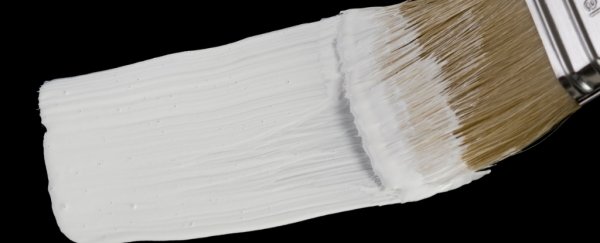Scientists have created a super white paint that is the yin to Vantablack's yang.
While ultra black materials can today absorb more than 99.96 percent of sunlight, this new super white coat can reflect 95.5 percent of all the photons that hit it.
Instead of warming up under direct light, objects painted with this new acrylic material can remain cooler than their surrounding temperature even under the Sun, which could allow for a new energy-efficient way to control temperature inside buildings.
Other "heat rejecting paints" we currently have can only reflect 80 to 90 percent of sunlight and cannot achieve lower-than-ambient temperatures.
"It is a persistent task to develop a below-ambient radiative cooling solution that offers a convenient single-layer particle-matrix paint form and high reliability," says mechanical engineer Xiulin Ruan at Purdue University in Indiana.
"This is critical to the wide application of radiative cooling and to alleviate the global warming effect."
In summertime, many modern buildings rely on air conditioning units that push heat from the inside of a building outside. This, along with excess heat generated through the intense energy required to achieve the cooling contributes to turning cities into "heat islands" and further exacerbates global warming.
Radiative cooling is a passive technology that reflects heat from a building out into space, but it's a lot harder to achieve than radiant heating.
Since the 1970s, scientists have been trying to figure out how to reflect enough sunlight so passive cooling is more effective than an active air conditioner.
Recently, some have even tried to put together 'reverse solar panels', which can capture some of that outgoing heat and convert it into energy, even at nighttime.
But right now these are still only concepts, and it's unclear whether such devices could actually work outside a mere simulation.
Painting residential and commercial buildings in super white could be a more feasible approach, at least in the near future.
The new acrylic paint was made using calcium carbonate fillers of a high particle concentration and of a broad range of sizes, which can efficiently scatter all the wavelengths of the solar spectrum.
The matrix of the paint also has a vibrational resonance peak, which ensures a high amount of heat is reflected outwards - at a rate much higher than what other cooling paints can achieve.
During two days of field tests in different locations and under various weather conditions, researchers tested the paint's radiative cooling abilities and found it could scatter 95.5 percent of sunlight, remaining 10 degrees C below ambient temperature at night and at least 1.7 degrees C below ambient temperatures at noon.
Compared to surfaces coated with the same thickness of commercial white paint, objects covered in the calcium carbonate paint maintained substantially lower temperatures in infrared footage.
What's more, this paint brushes on and dries in much the same way, and is abrasion resistant, waterproof and can withstand outdoor weathering for at least three weeks, although longer trials are currently underway.
"Our paint is compatible with the manufacturing process of commercial paint, and the cost may be comparable or even lower," says Ruan.
"The key is to ensure the reliability of the paint so that it is viable in long-term outdoor applications."
The authors say their paint is "the best radiative cooling performance reported", although they do acknowledge that during review of their results, another team published a paper arguing cooling paint should include high concentrations of wide band gap particles.
They also suggest incorporating fluorocarbon-based polymers, which show high resistance to weathering.
"Many conventional white paints, while engineered for durability, experience drops in solar reflectance over time," the other recent paper explains.
"Materials such as fluoropolymer-based binders could enhance reflectance lifetime and thereby lower year-averaged costs."
Creating a single-layer paint that can reflect heat directly out into space without requiring an energy input would be a huge win for the climate crisis, as cooling is usually powered by fossil fuels and has a big overall impact on global warming.
The new paint still has some more tests to undergo, but the patents have already been filed. The name has yet to be revealed.
The study was published in Cell Reports Physical Science.
